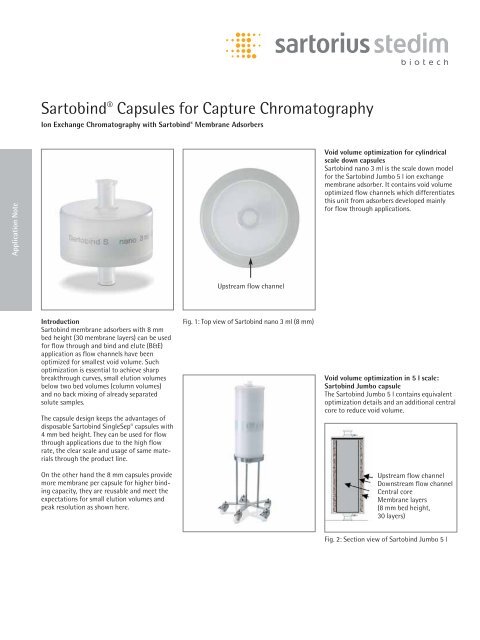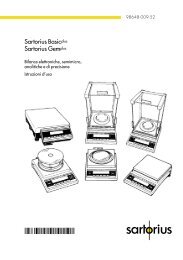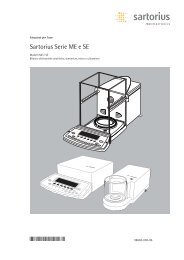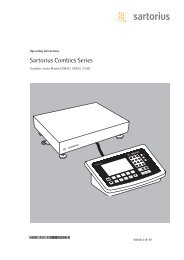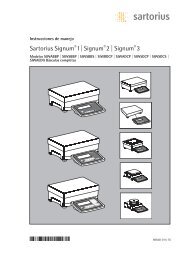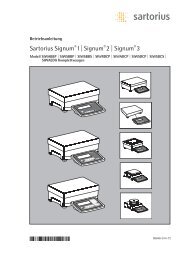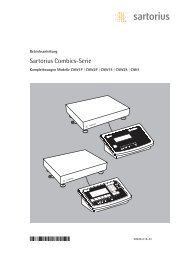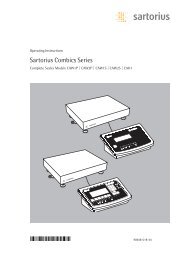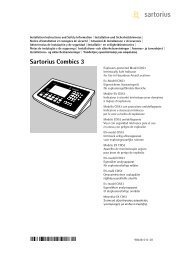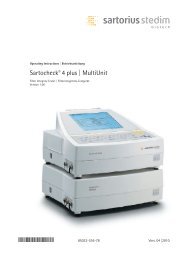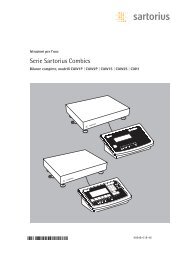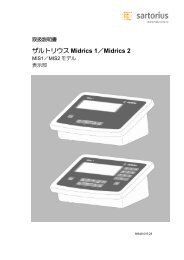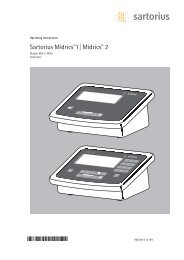Sartobind® Capsules for Capture Chromatography - Sartorius
Sartobind® Capsules for Capture Chromatography - Sartorius
Sartobind® Capsules for Capture Chromatography - Sartorius
Create successful ePaper yourself
Turn your PDF publications into a flip-book with our unique Google optimized e-Paper software.
Application Note<br />
Sartobind ® <strong>Capsules</strong> <strong>for</strong> <strong>Capture</strong> <strong>Chromatography</strong><br />
Ion Exchange <strong>Chromatography</strong> with Sartobind ® Membrane Adsorbers<br />
Introduction<br />
Sartobind membrane adsorbers with 8 mm<br />
bed height (30 membrane layers) can be used<br />
<strong>for</strong> flow through and bind and elute (B&E)<br />
application as flow channels have been<br />
optimized <strong>for</strong> smallest void volume. Such<br />
optimization is essential to achieve sharp<br />
breakthrough curves, small elution volumes<br />
below two bed volumes (column volumes)<br />
and no back mixing of already separated<br />
solute samples.<br />
The capsule design keeps the advantages of<br />
disposable Sartobind SingleSep ® capsules with<br />
4 mm bed height. They can be used <strong>for</strong> flow<br />
through applications due to the high flow<br />
rate, the clear scale and usage of same materials<br />
through the product line.<br />
On the other hand the 8 mm capsules provide<br />
more membrane per capsule <strong>for</strong> higher binding<br />
capacity, they are reusable and meet the<br />
expectations <strong>for</strong> small elution volumes and<br />
peak resolution as shown here.<br />
Upstream flow channel<br />
Fig. 1: Top view of Sartobind nano 3 ml (8 mm)<br />
Void volume optimization <strong>for</strong> cylindrical<br />
scale down capsules<br />
Sartobind nano 3 ml is the scale down model<br />
<strong>for</strong> the Sartobind Jumbo 5 l ion exchange<br />
membrane adsorber. It contains void volume<br />
optimized flow channels which differentiates<br />
this unit from adsorbers developed mainly<br />
<strong>for</strong> flow through applications.<br />
Void volume optimization in 5 l scale:<br />
Sartobind Jumbo capsule<br />
The Sartobind Jumbo 5 l contains equivalent<br />
optimization details and an additional central<br />
core to reduce void volume.<br />
Upstream flow channel<br />
Downstream flow channel<br />
Central core<br />
Membrane layers<br />
(8 mm bed height,<br />
30 layers)<br />
Fig. 2: Section view of Sartobind Jumbo 5 l
Scalability of Sartobind Q nano 3 ml<br />
to Q Jumbo 5 l<br />
Bovine serum albumin (BSA) 2 g/l in 10 mM<br />
potassium phosphate pH 7.4 was loaded at<br />
a flow rate of 4 bed volumes (BV) per minute<br />
on three different lots of Sartobind Q nano<br />
3 ml and Q Jumbo 5 l. The breakthrough<br />
curves were normalized to bed volume <strong>for</strong><br />
comparison. The six curves show equivalent<br />
shape of breakthrough behaviour as well<br />
as elution.<br />
Analysis of elution volume<br />
For the analysis a 1 % acetone in 10 mM<br />
potassium phosphate buffer pH 7.4 was ran<br />
over each three different nano and Jumbo<br />
capsules (Fig. 4). At 50 % acetone breakthrough,<br />
the breakthrough curve indicates<br />
a volume of ~1.6 bed volumes. Such elution<br />
volumes are similar to conventional void<br />
volume optimized columns.<br />
Bind & Elute per<strong>for</strong>mance of<br />
Sartobind Q Jumbo<br />
Sartobind Q Jumbo was loaded with 2 g/l BSA<br />
in 10 mM potassium phosphate buffer pH 7.4<br />
at a flow rate of 4 BV per minute (Fig. 5).<br />
The complete cycle of loading, washing and<br />
eluting with 220 l total buffer volume was<br />
achieved within 11 minutes. The profile shows<br />
a sharp breakthrough with a small elution<br />
volume of about 2 BV (10 l) and a dynamic<br />
binding capacity of ~90 g.<br />
c [g/l]<br />
3<br />
2,5<br />
2<br />
1,5<br />
1<br />
0,5<br />
0<br />
0<br />
10<br />
Fig. 3: Breakthrough curves of Sartobind Q Jumbo 5 ml and Q nano 3 ml normalized<br />
to the bed volume<br />
c/c0<br />
1,2<br />
1<br />
0,8<br />
0,6<br />
0,4<br />
0,2<br />
0<br />
0<br />
Fig. 4: Breakthrough of acetone in Sartobind Jumbo 5 l and nano 3 ml normalized<br />
to the bed volume<br />
e280nm<br />
3<br />
2,5<br />
2<br />
1,5<br />
1<br />
0,5<br />
Fig. 5: Breakthrough curve of Sartobind Q Jumbo 5 l<br />
1<br />
20<br />
2<br />
30<br />
BV<br />
3<br />
BV<br />
40<br />
4<br />
5<br />
lot A Jumbo 5l<br />
lot B Jumbo 5l<br />
lot C Jumbo 5l<br />
lot D nano 3ml<br />
lot E nano 3ml<br />
lot F nano 3ml<br />
50<br />
lot A Jumbo 5l<br />
lot B Jumbo 5l<br />
lot C Jumbo 5l<br />
lot D nano 3ml<br />
lot E nano 3ml<br />
lot F nano 3ml<br />
0<br />
0<br />
0 50 100 150<br />
V [l]<br />
200 250 300<br />
70<br />
60<br />
50<br />
40<br />
30<br />
20<br />
10<br />
6<br />
60<br />
Conductivity [mS/cm]
Separation of myoglobin, cytochrome c<br />
and lysozyme with Sartobind S nano 3 ml<br />
Sartobind nano 3 ml can be used <strong>for</strong> analytical<br />
protein purifications. The flow pattern<br />
display good resolution comparable to<br />
chromatographic column technology (Fig. 6).<br />
The main difference to columns is the high<br />
speed at which purification can be achieved.<br />
Flow rate was 10 ml/min (3.3 BV/min)<br />
Pre-conditioning 2 M NaCl in 20 BV<br />
equilibration<br />
buffer<br />
Equilibration 20 mM Tris 25 BV<br />
pH 7.4,<br />
1.8 mS/cm<br />
Loading of ~ 1-1.5 mg/ml 500 μl<br />
protein mixture <strong>for</strong> protein<br />
1, 2 and 3<br />
Wash 20 mM Tris 4 BV<br />
pH 7.4,<br />
1.8 mS/cm<br />
Elution by 2 M NaCl in 16 BV<br />
linear gradient equilibration<br />
buffer<br />
Separation of alpha-chymotrypsinogen A,<br />
ribonuclease and lysozyme with Sartobind<br />
S nano 3 ml<br />
The second example (Fig. 7) displays as well<br />
high resolution of three sample proteins<br />
within 10 minutes.<br />
Pre-conditioning 2 M NaCl in 20 BV<br />
equilibration<br />
buffer<br />
Equilibration 20 mM NaAC 25 BV<br />
pH 5.0,<br />
1.1 mS/cm<br />
Loading of ~ 1-1.5 mg/ml 500 μl<br />
protein mixture <strong>for</strong> protein<br />
1, 2 and 3<br />
Wash 20 mM NaAc 4 BV<br />
pH 5.0,<br />
1.1 mS/cm<br />
Elution by 2 M NaCl in 100 BV<br />
linear gradient equilibration<br />
buffer<br />
Summary<br />
Sartobind Jumbo and its void volume optimized<br />
scale down unit, Sartobind nano 3 ml,<br />
can be used <strong>for</strong> bind and elute applications.<br />
They show comparable and scaleable breakthrough<br />
behavior and elution volumes.<br />
Sartobind Membrane Adsorbers with 8 mm<br />
bed height are versatile as they can be used in<br />
flow through and bind and elute separations.<br />
1a Myoglobin (flow through)<br />
1b Myoglobin (bound)<br />
2 Cytochrome C<br />
3 Lysozyme<br />
Fig. 6: Separation of myoglobin, cytochrome C and lysozyme with Sartobind S nano 3 ml<br />
1 Alpha-chymotrypsinogen A<br />
2 Ribonuclease<br />
3 Lysozyme<br />
Fig. 7: Separation of alpha-chymotrypsinogen A, ribonuclease and lysozyme with<br />
Sartobind S nano 3 ml
<strong>Sartorius</strong> Stedim Biotech GmbH<br />
August-Spindler-Strasse 11<br />
37079 Goettingen, Germany<br />
Phone +49.551.308.0<br />
Fax +49.551.308.3289<br />
www.sartorius-stedim.com<br />
USA +1.800.3687178<br />
UK +44.1372.737159<br />
France +33.442.845600<br />
Italy +39.055.634041<br />
Spain +34.91.3586102<br />
Japan +81.3.37405407<br />
Sartobind ® is a trademark of<br />
<strong>Sartorius</strong> Stedim Biotech GmbH<br />
Technical data are subject to<br />
change without notice.<br />
Printed in Germany on paper that has been<br />
bleached without any use of chlorine.<br />
First published March 15, 2009<br />
Publication No.: SL-4052-e09031<br />
Order No.: 85034-536-64<br />
Ver. 03 | 2009


